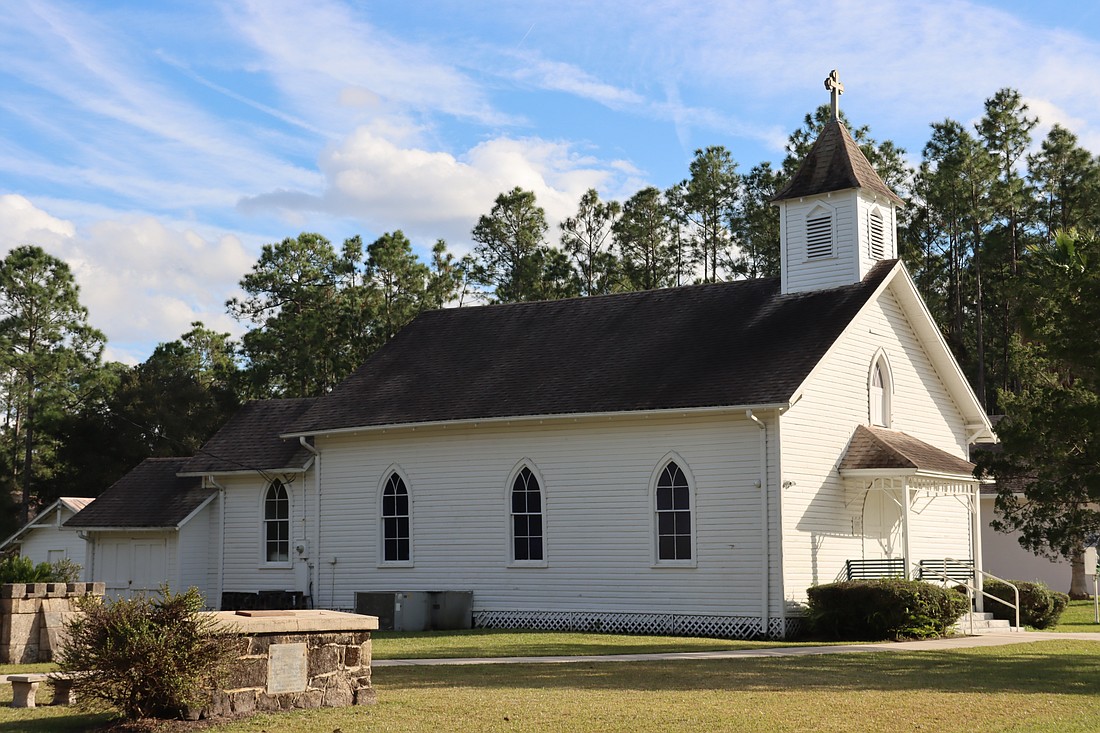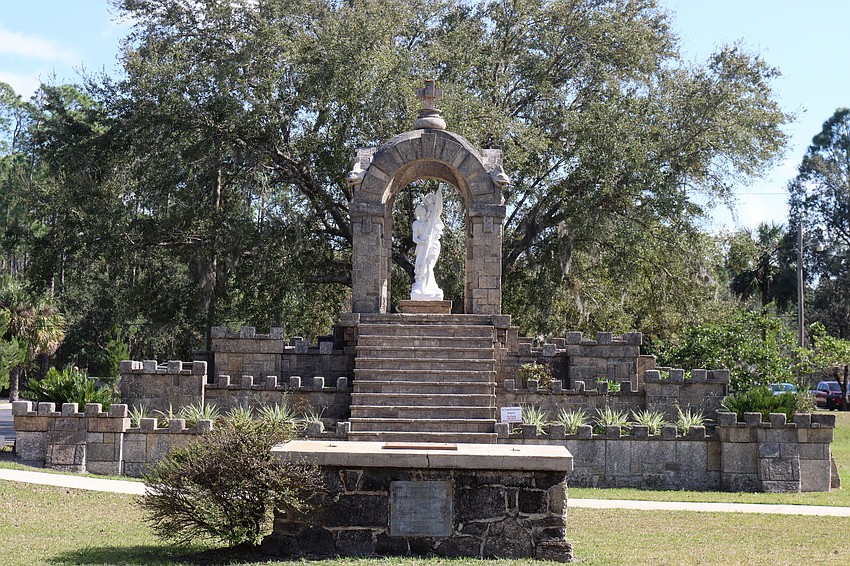- October 21, 2024
-
-
Loading

Loading

On Jan. 25, the St. Mary Catholic Church (also known as the St. Mary Mother Church) located at 89 St. Mary’s Place in Bunnell was added to the National Register of Historic Places.
The areas of its historic significance are architecture, ethnic heritage: European (Polish), and exploration/settlement. The adjacent Shrine of Saint Christopher structure was also included as a contributing resource.
The National Park Service defines the NRHP as, “the official list of the nation’s historic places worthy of preservation. Authorized by the National Historic Preservation Act of 1966, the NRHP is part of a national program to coordinate and support public and private efforts to identify, evaluate, and protect America’s historic and archeological resources.”
The author started the NRHP research and nomination activities almost seven years ago. Delays in the process included red tape at the Catholic Diocese of St. Augustine, and the COVID-19 pandemic. The old and popular saying “Good things come to those who wait” is surely applicable to this story.
The addition of the St. Mary Catholic Church increases the number of Flagler County properties on the NRHP to 13. The author also researched and successfully nominated the previous four: Espanola School House (2020), Bunnell Coquina City Hall (2019), Bunnell Water Tower (2019), and the Holden House (2018).

Flagler County was founded in 1917 from parts of Volusia and St. Johns counties. The community of Korona (which means “crown” in Polish) became part of Flagler County when it was founded, and is now an unincorporated community which uses Bunnell mailing addresses. At one time, the community of Korona had its own post office, but it was closed by the U.S. Postal Service in 1950.
Today, the St. Mary Catholic Church is presumably the oldest standing church building in Flagler County, and it has the distinction of actually predating the county’s founding.
The history of the St. Mary Catholic Church, originally named St. Mary, Queen of Poland, Catholic Church, begins with a group of families of Polish descent who relocated to Korona from several northern urban centers, including Chicago and Detroit. These people were predominantly farmers who were attracted to the area by advertisements in The Bunnell Home Builder (a newsletter published by the Bunnell Development Company, chartered in 1909, which operated offices in Bunnell and Chicago). These advertisements promised such things as fertile land costing only $35 per acre.
In 1914, shortly after they arrived in the area, these people built the church with the assistance of $1,000 that they previously raised. The church building was constructed in the Carpenter Gothic architectural style, which was popular in North America from the late 1800s into the early 1900s. The St. Mary Catholic Church is one of the only Catholic church buildings designed in the Carpenter Gothic architectural style in Florida, most others are Episcopalian.
The St. Mary Catholic Church building has 1,955 square feet. It measures 31 feet wide by 62 feet long, and includes a 3-foot wide by 11-foot long section of the garage that projects from the northeast corner of the building. The church has a steeply pitched gable roof with a prominent steeple located at its front section. The steeple houses a bell that can be manually rung using a rope located in the choir chamber. Original solid wood board and batten siding is affixed horizontally on the building’s white painted exterior. Abundant local pine and cypress wood was used for the framework and trim.
Carpenter Gothic architecture uses wood to fabricate stone features that were prevalent in authentic 12th to 16th century Gothic architecture. Local designers and house-carpenters applied the Carpenter Gothic architecture style in light-frame construction for mainly small domestic buildings, outbuildings and small churches.
In most churches that were constructed in the Carpenter Gothic architectural style, including the St. Mary Catholic Church, features include pointed-arch windows, jig-sawn wood trim, steep gables, board and batten siding, and a steeple.
Perhaps the most prominent feature of the St. Mary Catholic Church is its eight lancet windows, which are tall and narrow with a pointed top arch. The glass panes are clear and wavy. Interestingly, no colorful stained glass has ever been used in the windows of this church.
In the 1930s, two additions were added onto the back of the church building. One was an automobile garage, and the other provided living quarters (bathroom, bedroom, kitchen, living room, and a safe and storage room) for the resident priest. The additions were constructed with materials that matched the original church building.
The interior of the church features 14 solid wood pews (long benches with backs). The sanctuary rests on a slightly raised stage running the length of the east wall and includes simple wood rails on each of its sides. On the center of the east wall, there is a large ornate statue of Jesus on the Crucifix. On the right side of the sanctuary, there is a small altar, and in front of it is a Statue of the Redeemer in Death. The sanctuary also includes church service-related

artifacts and various paintings of biblical figures and saints.
The white painted interior walls of the church and sacristy room are finished with original solid hardwood bead board wainscoting, which runs vertically from the floor to the chair molding and horizontally above the chair molding to the ceiling. The white painted ceiling is finished with matching solid hardwood bead board.
The Shrine of Saint Christopher is a very unique structure that was built in 1935 for the purpose of providing a rest stop and haven for motorists to relax and pray to the Patron Saint of Travelers, protector against toothaches, hailstorms and sudden death. The structure is formed from concrete and covered with a veneer of locally quarried coquina rock and measures 28 feet by 40 feet and is 24 feet high. Highlights of the structure include short wall crenellations (also called battlements), which are stylistic features found on many Gothic Revival style churches.
The top section of the shrine has four square pillars connected by arches. One of the more interesting and stylish features is the four coquina rock fish carvings, which display their heads, dorsal fins, and a portion of their bodies protruding out from the corners of the arches.
Centrally located within the top arched section is a white marble statue of Saint Christopher holding a staff in his hands and looking up towards Christ, depicted as a child, who is sitting on his shoulder.
From the humble beginning of the St. Mary Catholic Church in 1914, it has played a significant role in the Korona community. To this day, the church is interconnected to the spiritual and cultural lives of many of the area’s people. The St. Mary Catholic Church building and the Shrine of Saint Christopher structure are certainly among Flagler County’s most impressive, important, and alluring historic sites.
The author sincerely acknowledges the efforts of Samantha Schmidt (Historic Preservationist), and Kyra Lucas (Supervisor – Survey, Registration, and Technical Services) of Florida’s Bureau of Historic Preservation for their assistance in preparing the nomination documentation for submission to the National Park Service.